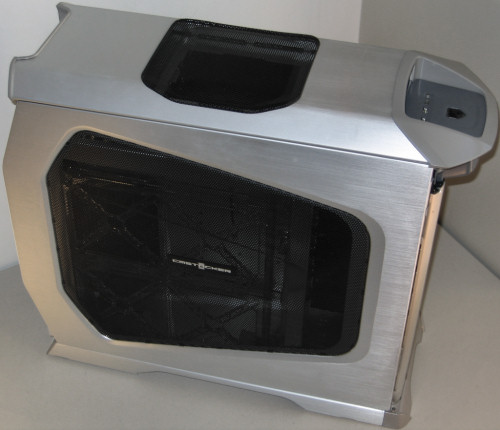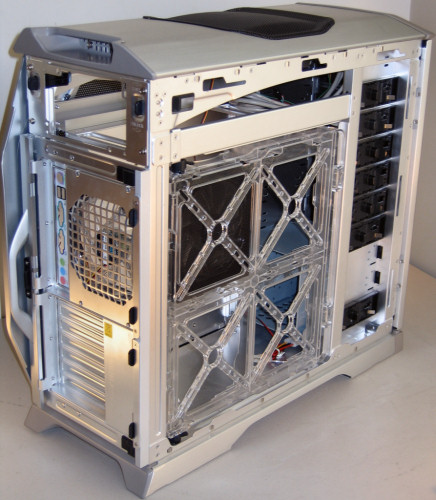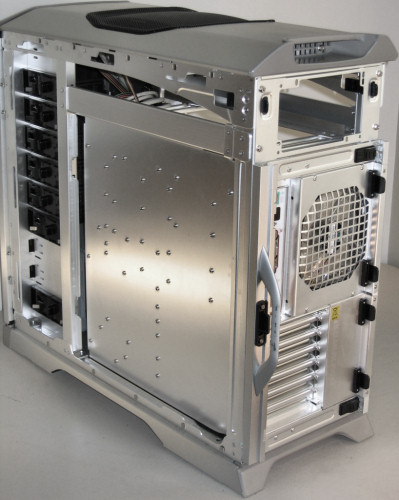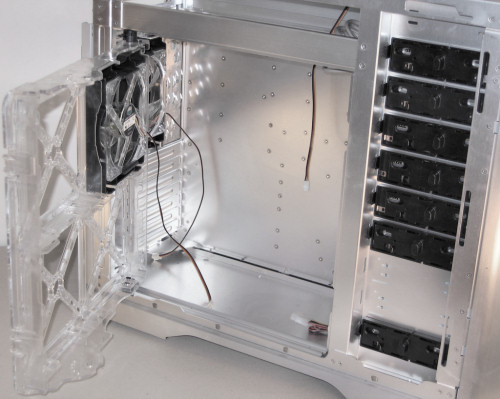Clash of the Titans - TT Tai Chi vs. CM Stacker 830
by Joshua Buss on February 23, 2006 12:05 AM EST- Posted in
- Cases/Cooling/PSUs
Cooler Master Stacker 830 (cont’d)
If the Tai Chi's approach to serious cooling is extreme conduction and convection, the new Stacker's approach is extreme venting and support for fans. In total, the 830 can hold 9 (yes, nine) 120mm fans. Four fit in the side panel (more on that later), three in the front attached to hard drive cages like the Tai Chi, one on top, and one in the rear. Now, we'll take a step back and examine the case from above at a further distance.
The top mounted vent on the 830 is passive by default (yet wasn’t in the system shipped to us), but a 120mm fan can be placed here if one desired. Something that pops out better in this picture than others is the handle configuration, which isn't as prominent as it is on the Tai Chi, but it is still just as useful and comfortable. Also in this shot, the holders for the four 120mm fans in the side are quite visible through the black mesh metal on the side.
Looking at the back of the case, we get an even better idea just how configurable this case is going to be. The first clue is that the side panels are very easy to remove – a clearly labeled black plastic tab on the top is all that keeps them from sliding back and detaching. Right next to these tabs are screws, which hold the plate that attaches to the PSU in place. While still slick, we prefer being able to slide a PSU in from the side of a case as it's slightly faster and easier, although modular power supplies are making this less of an issue. One of the three included 120mm fans is visible in this picture as well, exhausting the bulk of the warm air directly out the back.
With the left side panel off, much more of the Stacker 830 finally makes sense. The main feature, the 4x120mm fan array, is clear plastic and can swing out and be removed completely if desired. Only one fan is included in the panel, and it's identical to the fan in the back. It's also easier to notice that it's pretty much impossible to fit a power supply in from the side or underneath – it will have to fit through the back area.
Leaving the interesting left side for a bit, we should note that the right side is, for the most part, identical – but without the fan array, it looks pretty drab through the black grill and we'd caution users against exposing the right side of this case more so than the left considering how transparent the venting holes make the panel.
To keep the Stacker 830 tool-less, it uses removable plastic and steel locks, which slide pins into the respective 5¼” drives. They work well enough, but we prefer Thermaltake's more elegant thumbscrew solution, for aesthetic reasons. Screws could always be used here too, of course, but Cooler Master doesn't provide the same large thumbscrews Thermaltake does with the case.
One might notice that it could be a little harder to work inside the Stacker than most cases with the side fan cage in the way, but as noted above, it is a cinch to remove.
If the Tai Chi's approach to serious cooling is extreme conduction and convection, the new Stacker's approach is extreme venting and support for fans. In total, the 830 can hold 9 (yes, nine) 120mm fans. Four fit in the side panel (more on that later), three in the front attached to hard drive cages like the Tai Chi, one on top, and one in the rear. Now, we'll take a step back and examine the case from above at a further distance.
The top mounted vent on the 830 is passive by default (yet wasn’t in the system shipped to us), but a 120mm fan can be placed here if one desired. Something that pops out better in this picture than others is the handle configuration, which isn't as prominent as it is on the Tai Chi, but it is still just as useful and comfortable. Also in this shot, the holders for the four 120mm fans in the side are quite visible through the black mesh metal on the side.
Looking at the back of the case, we get an even better idea just how configurable this case is going to be. The first clue is that the side panels are very easy to remove – a clearly labeled black plastic tab on the top is all that keeps them from sliding back and detaching. Right next to these tabs are screws, which hold the plate that attaches to the PSU in place. While still slick, we prefer being able to slide a PSU in from the side of a case as it's slightly faster and easier, although modular power supplies are making this less of an issue. One of the three included 120mm fans is visible in this picture as well, exhausting the bulk of the warm air directly out the back.
With the left side panel off, much more of the Stacker 830 finally makes sense. The main feature, the 4x120mm fan array, is clear plastic and can swing out and be removed completely if desired. Only one fan is included in the panel, and it's identical to the fan in the back. It's also easier to notice that it's pretty much impossible to fit a power supply in from the side or underneath – it will have to fit through the back area.
Leaving the interesting left side for a bit, we should note that the right side is, for the most part, identical – but without the fan array, it looks pretty drab through the black grill and we'd caution users against exposing the right side of this case more so than the left considering how transparent the venting holes make the panel.
To keep the Stacker 830 tool-less, it uses removable plastic and steel locks, which slide pins into the respective 5¼” drives. They work well enough, but we prefer Thermaltake's more elegant thumbscrew solution, for aesthetic reasons. Screws could always be used here too, of course, but Cooler Master doesn't provide the same large thumbscrews Thermaltake does with the case.
One might notice that it could be a little harder to work inside the Stacker than most cases with the side fan cage in the way, but as noted above, it is a cinch to remove.















55 Comments
View All Comments
JoshuaBuss - Sunday, February 26, 2006 - link
The stacker 830 would probably be a perfect case for someone like you.. it has the potential for an incredible amount of air flow right at the hard drives and video cardstjr508 - Friday, February 24, 2006 - link
This article states the front bay pannes on the CM case are held in loosely. I find that strange being my $50 CM case (awsome case) actually uses screws to hold these in place, making them the most secure that I have ever seen. I wonder why CM felt it important to secure these tightly on their $50 cases but not on their $250 case?chynn - Thursday, March 2, 2006 - link
Wrong! What Anandtech did not do with the RC-830 was to lock the 4to3 drive bays down with the provided screws. The snap locks are there only to position the drive bays, and anything else, that fit into the 5.25in slots.Only the Lian-Li V1000 and V1200 cases, in my experience, have a fool-proof and moron-tolerant hard drive locking mechanism.
JoshuaBuss - Monday, May 15, 2006 - link
I was referring to the pop-out panels that cover unused 5 1/4" drive bays. They're very loose, and there's no screws for holding them in place.BikeDude - Friday, February 24, 2006 - link
I have been using the Armor case for almost a year, and the green plastic clips still gives me nightmares.If you get impatient, they'll simply detach and you'll have to nudge them back in again. In practice, I've wasted a lot of time nursing cards underneath the clips, reattaching the clips and finally pray it all fits in the end.
Even a simple old-school phillipshead screw would've saved me _a lot_ of time!
It is disheartening to see that TT not only makes mistakes, but insist on repeating them. :(
Also, the four holes for watercooling, on my Armor case atleast, are positioned too close. Atleast when attaching the Zalman Reserator-1 system. With the reserator you can choose to have a junction there so that you can more easily detach the cooler and move the case... Won't work if you have two Reserators...
Tamale - Friday, February 24, 2006 - link
Interesting point about the reserators.. what's the junction exactly?As for the green clips, I tend to agree.. it's a shame they didn't come up with a solution as elegant as the thumbscrews used to hold the 5 1/4" drives.. but for the majority of cards they do work very nicely.
theoak - Friday, February 24, 2006 - link
The reviewer calls this a tie.If keeping your components cool is the objective, I feel that the 830 wins by a landslide.
If you look neer the end of the review at the heat comparison chart, the 830 wins or ties all but two (HDD and System Exhaust).
The reviews gives the system exhaust win to the Tai Chi. I have to disagree. The fact that the components are cooler, implies to me that the system exhaust would therefore have to be hotter, because it is cooling the components better.
If you take the sum of the exhaust results you get:
Tai Chi 54.2/60.4
830 53.4/59.6
The combined values I feel demonstrate that the air temperature in the 830 is cooler and hence offers better airflow.
(I do not work for either of these companies nor do I own either of the boxes. My computer is a P3 650 :( )
Tamale - Friday, February 24, 2006 - link
You're absolutely right.. the 830 did a slightly better job of cooling than the Tai Chi did in our comparison.. BUT.. it was using FOUR 120mm fans to accomplish this as oppossed to the Tai Chi's two. The fans aren't rated that different in terms of CFM, so adding even a single fan to the side of the Tai Chi would undoubtedly bring its temperatures even closer to the stacker's.chynn - Thursday, March 2, 2006 - link
Anandtech got a "non-stock" RC-830 case. The "stock" RC-830 case I received contained two fans, not four.Besides, stock case fans are usually less than adequate. I would replace them with 120mm Scythe SFF21F fans because the Scythe have: high MTBF (150,000hrs), more volume (63+CFM), and lower noise (fluid bearing 28DBa). If that's too much noise, use a D or E model; less noise but less air too.
And no, I don't work for Scythe ... I'm opinionated is all ... :)
theoak - Friday, February 24, 2006 - link
Ahhh,I was unaware and/or missed that the 830 had more fans. That would tip the scales a little.
For what its worth ... I agree that it is a tie then :)